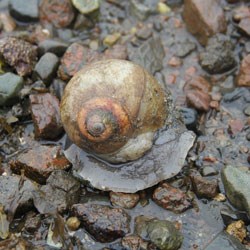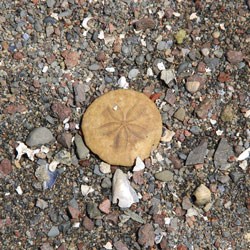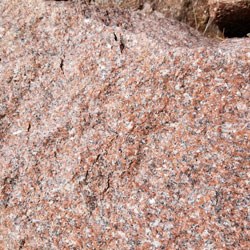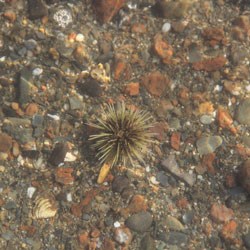TidesApproximately twice per day, the water and islands of the St. Croix River reveal an extraordinary phenomenon: the extreme tides of the Maine coast. When the positions of the sun and moon are on the far side of the earth, the tides can drop below sea level, revealing shellfish, sea urchins, and sediments normally underwater. Take photographs at low tide, then return to the same location at high tide. An entirely new landscape will be revealed!
Left image
Right image
TidepoolsAs the tides receed, they leave behind plants and animals. Enjoy looking for creatures among the pools but remember to always leave what you find. Here are some interesting features, plants and animals that you may find.
NPSPhoto/Albrecht SnailsAt low tide, hidden in the Sargassum Seaweed are an abundance of gastropods or snails. The diversity of snails found along the shores of the St. Croix River is extensive due to the fast currents allowing a nutrient rich environment for the snails to thrive. One extraordinary species (Lunati heros) commonly known as the Northern Moon Snail can grow to an amazing four inches in size and is often seen by the keen eye half burrowed in the sediment at low tide. The National Park Service wants all people now and into the future to discover these amazing crustaceans, so remember, collect them with photos but leave them to stay in the park for future visitors to enjoy. 
NPSPhoto/Albrecht Sand DollarsMany visitors to Saint Croix Island International Historic Park are amazed to find out the waters of the St. Croix River are brackish. The salt content causes many oceanic creatures to thrive in this tidal habitat. Sand dollars are a flat, burrowing class of sea urchin which loses its hairlike spikes when it dies. Composed of calcium carbonate plates arranged in a fivefold pattern, the joy of finding a sand dollar creates a lifelong memory. Remember, a great personal challenge of visiting a national park is to not collect sand dollars. Only take pictures so other visitors to the park will enjoy the same magical discovery. Sand dollars prefer warmer water, so they are mostly found in the shallowest parts of the St. Croix River where it is warmest. They are most often discovered on the beach in which they burrow at low tide. 
NPSPhoto/Albrecht Pink Granite and SeaweedPink granite can be seen along the shores of the St. Croix River. At first glance they can see a pink stripe on what appears to be a dark base of mud. The dark base is actually Sargassum Seaweed, a common seaweed found in saltwater. It often has fluid filled pods, and it washes ashore because of the changing currents of the St. Croix River. Though the currents can be quite strong, pink granite has provided stability all along the St. Croix River. Pink granite is an igneous rock indicating that at one time, the area of the St. Croix River was volcanic. The pink is due to the high potassium feldspar content, a mineral commonly found in granite. 
NPSPhoto/Albrecht Sea UrchinsIs that a Cactus in the Water? At low tide amazing creatures called sea urchins may show up on the beach or in the shallow water. They can range from the size of a marble up to that of a softball. The waters around Saint Croix Island IHS are teeming with sea urchins. The spikes you see on a sea urchin move and act like hundreds of feet. When trapped in the gravel exposed by the tides, many sea urchins will camouflage themselves by pulling rocks in between their spikes until the tide rises. Crabs and lobsters prey on sea urchins in the St. Croix River. Information About Tides and Tidepools From Around the NPS |
Last updated: June 8, 2024
